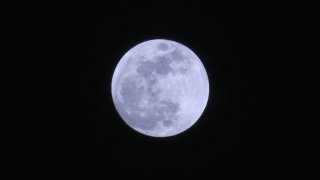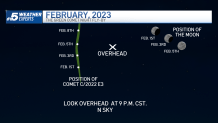
A GREEN COMET ENCOUNTER
A green comet discovered in March 2022 will make its closest approach to Earth by month's end.

The comet C/2022 E3 (ZTF) was first discovered by astronomers at California's Zwicky Transient Facility when it was passing Jupiter. The comet will become more visible as it moves closer to the planet.
Get DFW local news, weather forecasts and entertainment stories to your inbox. Sign up for NBC DFW newsletters.
It’s forecast to be brightest around February 2nd, when the comet is at its closest point to Earth. It will be 26 million miles away from us at its closest approach.
It will appear as a faint, fuzzy glow or smear of light. Under a city or suburban sky, you’ll need binoculars or a small telescope to actually see this comet. Even far from urban lights, you’ll likely still need binoculars because when the comet is brightest, the bright Moon will be in the sky at the same time, making viewing more difficult. You can find the comet in the night as it moves overhead in the northern sky.

The last time this comet passed close to the Earth was 50,000 years ago, that is when Neanderthals roamed the planet.
INTERNATIONAL SPACE STATION FLY-BYS

The International Space Station will make flybys across North Texas sky this month. The ISS appears as a fast-moving star across the night sky.

The International Space Station rotates around the Earth at a speed of 17,500 mph. The ISS rotates about its center of mass at a rate of about 4 degrees per minute so that it will complete a full rotation once per orbit. This allows it to keep its belly towards the Earth. One revolution around the planet takes about 90 minutes (16 per day).
Weather Connection
Connecting you with your forecast and all the things that make North Texas weather unique.
Also, the International Space Station lies at an altitude of 250 miles above the Earth. By the way, that is 1.32 million feet. Most commercial airplanes fly between 33,000 to 42,000 feet.
CLOSE TO YOU: JUPITER AND VENUS
Venus and Jupiter are holding close together this month.

An hour or so after sunset, look in the southwest sky to see both planets. Venus will be lower and the brighter of the two planets. As the month goes on, they appear to move closer together each night. By the end of the month, the two appear only about one degree apart in the southwest sky.
Btw, the two planets are over 400 million miles apart in space. Venus's distance from the Earth varies from 24 million miles to 162 million miles. Jupiter's distance from the Earth varies from 336 million miles to 600 million miles.
MERCURY RISING
Mercury, the planet closest to the Sun, will continue to rise in the morning sky for the first few mornings of the month.

Look to the east-southeast horizon to spot Mercury rising shortly before dawn. However, with the Sun rising earlier each morning this month, Mercury will be difficult, if not impossible, to see in the increasingly bright sky.
As always, stop looking before the Sun reaches the horizon, or you risk permanent eye damage. Mercury averages a distance from the Earth at 48 million miles and from the Sun at 36 million miles.
AND THEN THERE'S, MARS
Mars, having reached its brightest peak back in December, is getting noticeably dimmer as the month passes. It is still high in the early-evening sky, distinctively reddish, and brighter than any star near it.

Mars reaches its peak in the southern sky at night. Mars sets in the west-northwest around 3:00 a.m. CST. at the start of the month, and at about 2:00 a.m. CST. by month’s end.
Mars averages a distance from the Earth at 140 million miles. The closest recorded distance to Mars from Earth was recorded in August 2003 when the two were 34.8 million miles apart. According to NASA, the two will not be that close again until the year 2237.
A SNOW/HUNGER MOON
On February 5th, there is a February full moon.

This full moon is called the "Snow Moon". It gets its name after snow on the ground during the month of February. Some Native American tribes call it the "Hunger Moon" due to the scarce food sources and hard hunting conditions during mid-winter.
Please enjoy these events happening in the night sky this month. Until then...Texans, keep looking up!



